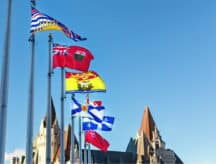Canada is now sending work and study permits by mail
Foreign nationals who are in Canada and who have been approved to work or study can now get their permits sent to them by mail.
Immigration, Refugees and Citizenship Canada (IRCC) is now opening up its web form to take requests from people who have their Letter of Introductions (LOIs) but no way to travel to a port of entry to claim their permits.
The new measure also extends to people who got their LOI under the International Experience Canada program.
Coronavirus travel restrictions have left many of these LOI holders in limbo. Though they have been approved to work or study, they can't get their permits unless they go to a port of entry. They can't go to a port of entry because it is not considered essential travel. So, they can't get their work or study permit, which means they cannot legally start working or studying even though they have already been approved.
The new process will allow these people to request their study or work permit online and have their papers mailed to them. IRCC says this option is available until March 31, 2021.
Get Help with Your Canadian Work Permit. Contact a Lawyer from the Law Firm of Campbell Cohen.
The new procedure to get your work or study permit in Canada
LOI holders will have a slightly different process depending on if they're coming to work or study.
When filling out the IRCC web form, study permit applicants should write:
A11EXAM: I am requesting an examination and the issuance of my study permit from within Canada. My application number is [S#########]. I have received my letter of introduction, which is valid until [DATE].
My correct contact information in Canada is:
Telephone:
Mailing Address:
Residential Address:I continue to be accepted at [DLI Name] and will be/am registered in the [Name] Program.
Officials will then review the study permit application to verify that the name of the Designated Learning Institution in the request matches the letter of acceptance. They will also check to see if the applicant's school is still accepting foreign students, and that their program has not been cancelled. Finally, they will have to be satisfied that there is still funding in place for tuition, living expenses and their return home.
Work permit applicants should use the following message:
A11EXAM: I am requesting an examination and the issuance of my work permit from within Canada. My application number is [W#########]. I have received my letter of introduction, which is valid until [DATE].
My correct contact information in Canada is:
Telephone:
Mailing Address:
Residential Address:
Applicants should also include one of the following paragraphs, depending on whether they're applying for an employer-specific work permit, or an open work permit.
Employer-specific work permit: My employer, [name], located at [address], may be contacted at [contact telephone or email] to confirm my continued employment offer. I intend to begin work for this employer as soon as my work permit is received.
Open work permit: I attest that my circumstances remain the same and I still meet the requirements of the open work permit program I was approved for.
The immigration department will check to see that the name of the employer in the Labour Market Impact Assessment (LMIA) or LMIA-exempt offer matches what the applicant provided in their request. They will also look for any concerns or case notes entered after the approval was issued.
Officers may contact the employer to confirm the job offer. They may also contact the applicant for an interview if they think it is necessary.
Though they may check open source information to confirm the employer, any information that they discover that could lead them to refuse the permit must be followed up by the procedural fairness process.
If the work or study permit is refused, officers must add case notes indicating why they reached a negative decision based off the application. They must also advise the applicant that when their status expires they must leave Canada, or advise them of the next steps if the foreign national is out of status.
Applicants who are approved for their permits will receive their documents in the mail, and finally be able to work or study in Canada.
Get Help with Your Canadian Work Permit. Contact a Lawyer from the Law Firm of Campbell Cohen.
© 2020 CIC News All Rights Reserved
- Do you need Canadian immigration assistance? Contact the Contact Cohen Immigration Law firm by completing our form
- Send us your feedback or your non-legal assistance questions by emailing us at media@canadavisa.com







